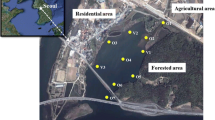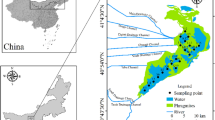Abstract
Nearly half of freshwater wetlands have been lost due to human disturbance. In response, wetlands are being restored to retain their ecosystem services. A potentially adverse consequence of wetland function is the production of methylmercury (MeHg). We measured concentrations of mercury (Hg) species and ancillary parameters in groundwaters and surface waters from four natural and 16 restored wetlands in northern New York State, USA to investigate differences in concentrations of Hg species among wetlands. We found no obvious differences in concentrations of total mercury (THg) and methylmercury in pond waters between natural and restored wetlands. High values of %methylmercury were evident in both ground (38.8 ± 27.6%) and surface waters (43.4 ± 25.6%) suggesting these wetland complexes are highly efficient in converting ionic Hg to methylmercury, regardless if restored or natural. High methylation efficiency may be due to observed drying and rewetting cycles. Hg in pond waters is likely derived from direct atmospheric deposition or by mobilization from near-wetland shallow sediments, in addition to groundwater inflows. Water flow of groundwaters from the associated watershed into pond waters resulted in increases in concentrations of THg and methylmercury. Dissolved organic matter likely plays an important role in the supply of Hg to pond waters. Relationships between methylmercury and %methylmercury with sulfate and nitrate in groundwaters may suggest some chemical limitation on Hg methylation at higher concentrations of these anions. Because of the similarity in Hg dynamics for natural and restored wetlands, the most effective strategy to mitigate methylmercury production would be to decrease atmospheric Hg deposition.





Similar content being viewed by others
References
Benoit JM, Gilmour CC, Heyes A, Mason RP, Miller C (2003) Geochemical and biological controls over methylmercury production and degradation in aquatic ecosystems. In: Chai Y (ed) ACS Symp. Ser. 835, OC Braids, pp 262–297. Washington, DC: Am. Chem. Soc. https://doi.org/10.1021/bk-2003-0835.ch019
Chen CY, Driscoll CT, Kamman NC (2012) Mercury hotspots in freshwater ecosystems: drivers, processes, and patterns. In: Bank MS (ed) Mercury in the environment: pattern and process. University of California Press, Berkeley, CA, p 352
Dahl TE (2011) Status and trends of wetlands in the conterminous United States 2004 to 2009. U.S. Department of the Interior, U.S. Fish and Wildlife Service, Fisheries and Habitat Conservation, Washington, DC, p 107
Denkenberger JS, Driscoll CT, Branfireun BA, Eckley CS, Cohen M, Selvendiran P (2012) A synthesis of rates and controls on elemental mercury evasion in the Great Lakes Basin. Environ Pollut 161:291–298
Dennis IF et al. (2005) Distribution patterns of mercury in lakes and rivers of northeastern North America. Ecotoxicology 14:113–123. https://doi.org/10.1007/s10646-004-6263-0
Dittman JA, Driscoll CT, Groffman PM, Fahey TJ (2007) Dynamics of nitrogen and dissolved organic carbon at the Hubbard Brook Experimental Forest. Ecology 88(5):1153–1166. https://doi.org/10.1890/06-0834
Dittman JA, Shanley JB, Driscoll CT, Aiken GR, Chalmers AT, Towse JE, Selvendiran P (2010) Mercury dynamics in relation to dissolved organic carbon concentration and quality during high flow events in three northeastern U.S. streams. Water Resour Res 46(7):1–15. https://doi.org/10.1029/2009WR008351
Driscoll CT et al. (2007) Mercury Matters: Linking Mercury Science with Public Policy in the Northeastern United States. Hubbard Brook Research Foundation, Science Links Publication. Vol. 1, no. 3
Driscoll CT, Holsapple J, Schofield CL, Munson R (1998) The chemistry and transport of mercury in a small wetland in the Adirondack region of New York, USA. Biogeochemistry 40:10
Driscoll CT, Mason RP, Chan HM, Jacob DJ, Pirrone N (2013) Mercury as a global pollutant: Sources, pathways, and effects. Environ Sci Technol 47:4967–4983
Eckley CS, Luxton TP, Goetz J, McKernan J (2017) Water-level fluctuations influence sediment porewater chemistry and methylmercury production in a flood-control reservoir. Environ Pollut 222:32–41. https://doi.org/10.1016/j.envpol.2017.01.010
Fitzgerald WF, Engstrom DR, Mason RP, Nater EA (1998) The case for atmospheric mercury contamination in remote areas. Environ Sci Technol 32:1–7. https://doi.org/10.1021/es970284w
Franzi DA, Ridge JC, Pair DL, Desimone D, Rayburn JA, Barclay DJ (2000) Post-valley heads deglaciation of the Adirondack Mountains and Adjacent Lowlands Adirondack. J Environ Stud 21:119–146
Galloway ME, Branfireun BA (2004) Mercury dynamics of a temperate forested wetland. Sci Total Environ 325:239–254. https://doi.org/10.1016/j.scitotenv.2003.11.010
Gerson JR, Driscoll CT (2016) Is mercury in remote forested watershed of the Adirondack Mountains responding to recent decreases in emissions? Environ Sci Technol 50:10943–10950. https://doi.org/10.1021/acs.est.6b02127
Gilmour CC, Henry EA (1991) Mercury methylation in aquatic systems affected by acid deposition. Environ Pollut 71:131–169. https://doi.org/10.1016/0269-7491(91)90031-Q
Gilmour CC, Riedel GS, Ederington MC, Bell JT, Gill GA, Stordal MC (1998) Methylmercury concentrations and production rates across a trophic gradient in the northern Everglades. Biogeochemistry 40:327–345. https://doi.org/10.1023/a:1005972708616
Glimour CC (2011) A review of the literature on the impact of sulfate on methylmercury in sediments and soils. Smithsonian Environmental Research Center, Edgewater, MD
Hogan DM, Jordan TE, Walbridge MR (2004) Phosphorus retention and soil organic carbon in restored and natural freshwater wetlands. Wetlands 24:573–585. https://doi.org/10.1672/0277-5212(2004)024[0573:PRASOC]2.0.CO
Hwang K (2018) Ecohydrology of natural and restored wetlands in a glacial plain. Dissertations – ALL. 990. https://surface.syr.edu/etd/990
Kwon SY, Selin NE, Giang A, Karplus VJ, Zhang D (2018) Present and future mercury concentrations in Chinese rice: insights from modeling. Glob Biogeochem Cycles 32:437–462. https://doi.org/10.1002/2017GB005824
Lacerda LD, Fitzgerald WF (2001) Biogeochemistry of mercury in wetlands. Wetl Ecol Manag 9:291–293. https://doi.org/10.1023/a:1011851432573
Liu G et al. (2008) Distribution of total and methylmercury in different ecosystem compartments in the Everglades: implications for mercury bioaccumulation. Environ Pollut 153:257–265. https://doi.org/10.1016/j.envpol.2007.08.030
Matthews DA et al. (2013) Whole-lake nitrate addition for control of methylmercury in mercury-contaminated Onondaga Lake, NY. Environ Res 125:52–60. https://doi.org/10.1016/j.envres.2013.03.011
Minitab I (2014) Minitab Statistical Software, Release 17 for Windows, State College, Pennsylvania Minitab® is a registered trademark of Minitab, Inc. http://www.minitab.com
Mitsch WJ, Gosselink JG (2007) Wetlands, 4th edn. John Wiley & Sons, New York, NY
Mitchell CPJ, Branfireun BA, Kolka RK (2008) Total mercury and methylmercury dynamics in upland–peatland watersheds during snowmelt. Biogeochemistry 90:225–241. https://doi.org/10.1007/s10533-008-9246-z
National Research Council (2001) Executive summary. In: Compensating for Wetland Losses Under the Clean Water Act. National Academies Press, Washington, DC, p 1–10
Podar M et al. (2015) Global prevalence and distribution of genes and microorganisms involved in mercury methylation. Sci Adv 1:e1500675. https://doi.org/10.1126/sciadv.1500675
R Core Team (2017) R: a language and environment for statistical computing. R Foundation for Statistical Computing, Vienna, Austria. https://www.R-project.org/
Selvendiran P, Driscoll CT, Bushey JT, Montesdeoca MR (2008) Wetland influence on mercury fate and transport in a temperate forested watershed. Environ Pollut 154:46–55. https://doi.org/10.1016/j.envpol.2007.12.005
Selvendiran P, Driscoll CT, Montesdeoca MR, Choi HD, Holsen TM (2009) Mercury dynamics and transport in two Adirondack lakes. Limnol Oceanogr 54(2):413–427. https://doi.org/10.4319/lo.2009.54.2.0413
Shih R, Robertson WD, Schiff SL, Rudolph DL (2011) Nitrate controls methylmercury production in a streambed bioreactor. J Environ Qual 40:1586–1592. https://doi.org/10.2134/jeq2011.0072
Sinclair KA, Xie Q, Mitchell CPJ (2012) Methylmercury in water, sediment, and invertebrates in created wetlands of Rouge Park, Toronto, Canada. Environ Pollut 171:207–215. https://doi.org/10.1016/j.envpol.2012.07.043
Smith DB, Cannon WF, Woodruff LG, Solano F, Ellefsen KJ (2014) Geochemical and mineralogical maps for soils of the conterminous United States. Open-File Report, (2014–1082). https://doi.org/10.3133/ofr20141082
Strickman RJ, Mitchell CPJ (2017) Methylmercury production and accumulation in urban stormwater ponds and habitat wetlands. Environ Pollut 221:326–334. https://doi.org/10.1016/j.envpol.2016.11.082
Strickman RJ, Mitchell CPJ (2018) Multifunctional wetlands: pollution abatement and other ecological services from natural and constructed Wetlands. In: Environmental contamination remediation and management. Springer, Cham. https://doi.org/10.1007/978-3-319-67416-2
Sunderland EM, Driscoll CT, Hammitt JK, Grandjean P, Evans JS, Blum JD, Jacobs W (2016) Benefits of Regulating Hazardous Air Pollutants from Coal and Oil-Fired Utilities in the United States. Environ Sci Technol 50:2117–2120. https://doi.org/10.1021/acs.est.6b00239
Sunderland EM, Li M, Bullard K (2018) Decadal changes in the edible supply of seafood and methylmercury exposure in the United States. Environ Health Perspect 126:017006. https://doi.org/10.1289/EHP2644
Todorova SG, Driscoll CT, Matthews DA, Effler SW, Hines ME, Henry EA (2009) Evidence for regulation of monomethyl mercury by nitrate in a seasonally stratified, eutrophic lake. Environ Sci Technol 43:6572–6578. https://doi.org/10.1021/es900887b
US EPA (2002) Method 1631, Revision E: mercury in water by oxidation, purge and trap, and cold vapor atomic fluorescence spectrometry. U.S. Environmental Protection Agency, Washington, DC
Ullrich SM, Tanton TW, Abdrashitova SA (2001) Mercury in the aquatic environment: a review of factors affecting methylation. Crit Rev Environ Sci Technol 31:241–293. https://doi.org/10.1080/20016491089226
UNEP (2019) Global mercury assessment 2018. UN Environment Programme, Chemicals and Heava, Switzerland
Wasik JKC, Engstrom DR, Mitchell CPJ, Swain EB, Monson BA, Balogh SJ, Almendinger JE (2015) The effects of hydrologic fluctuation and sulfate regeneration on mercury cycling in an experimental peatland. J Geophys Res Biogeosci Res 120:1697–1715. https://doi.org/10.1002/2015JG002993
Yu X, Driscoll CT, Warby RAF, Montesdeoca M, Johnson CE (2014) Soil mercury and its response to atmospheric mercury deposition across the northeastern United States. Ecol Appl 24:812–822
Zedler JB, Kercher S (2005) Wetland resources: status, trends, ecosystem services, and restorability. Annu Rev Environ Resour 30:39–74. https://doi.org/10.1146/annurev.energy.30.050504.144248
Zhang H, Feng X, Larssen T, Qiu G, Vogt RD (2010) In Inland China, rice, rather than fish, is the major pathway for methylmercury exposure. Environ Health Perspect 118:1183–1188
Zhang Y et al. (2016) Observed decrease in atmospheric mercury explained by global decline in anthropogenic emissions. Proc Natl Acad Sci 113:526–531. https://doi.org/10.1073/pnas.1516312113
Zhao L et al. (2016) Mercury methylation in rice paddies and its possible controlling factors in the Hg mining area, Guizhou province, Southwest China. Environ Pollut 215:1–9. https://doi.org/10.1016/j.envpol.2016.05.001
Zillioux E, Porcella DB, Benoit JM (1993) Freshwater wetland ecosystems. Environ Toxicol Chem 12:2245–2264. https://doi.org/10.1897/1552-8618
Acknowledgements
This study was funded by the University of Michigan Water Center. We thank personal from Clarkson University for their support of this study; Laura Lautz and Zeng Teng for valuable advice editing the paper; Nicholas Glick and Mariah Shannon Taylor for lab training; and Jacqueline Gerson, Geoffrey Dean Millard, Linghui Meng, Weiyao Gu and Habibollah Fakhraei for useful suggestions on data analysis and paper editing.
Funding
This study was funded by the University of Michigan Water Center. Contract # N017025.
Author information
Authors and Affiliations
Corresponding author
Ethics declarations
Conflict of interest
The authors declare that they have no conflict of interest.
Additional information
Publisher’s note Springer Nature remains neutral with regard to jurisdictional claims in published maps and institutional affiliations.
Rights and permissions
About this article
Cite this article
Wang, T., Driscoll, C.T., Hwang, K. et al. Total and methylmercury concentrations in ground and surface waters in natural and restored freshwater wetlands in northern New York. Ecotoxicology 29, 1602–1613 (2020). https://doi.org/10.1007/s10646-019-02155-6
Accepted:
Published:
Issue Date:
DOI: https://doi.org/10.1007/s10646-019-02155-6




